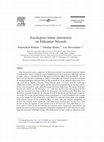Papers by selamyihun kidanu

Agroforestry Systems, 2005
In recent years, Eucalyptus globulus planted along field boundaries has come to dominate the cent... more In recent years, Eucalyptus globulus planted along field boundaries has come to dominate the central highland landscape of Ethiopia. Although evidence is scanty, there is a perception that this practice adversely affects crop productivity. An on-farm trial was conducted on Pellic Vertisol at Ginchi to determine the production potential of eucalypt boundaries and their effect on the productivity of adjacent crops of tef (Eragrostis tef) and wheat (Triticum sp.). The experiment comprised three stand ages, four field aspects and six distances from the tree-crop interface, using a split-split plot design with three replicates. Wood production rates ranged between 168 kg ha−1 y−1 (four years old) and 2901 kg ha−1 y−1 (twelve years). Thus eucalypt boundaries planted on a hectare of land would satisfy 50 to 75% of the annual biomass energy requirement of a rural household of five persons. Significant depression of tef and wheat yields occurred over the first 12m from the tree line: the reduction was 20 to 73% for tef and 20 to 51% for wheat, equivalent to yield losses of 4.4 to 26% and 4.5 to 10% per hectare respectively. Nevertheless, in financial terms, the tree component adequately compensated for crop yield reduction and even generated additional income. Therefore, eucalypt boundaries have great potential to satisfy the rising demand for wood, without requiring a major change in land use on the highland Vertisols. The greater availability of wood will reduce the demand for dung and crop residues for fuel, and thus may contribute to improved soil management on croplands while relieving the increasing pressure on indigenous forest and woodlands.

Agricultural Systems, 2004
Over the past few years a single row of Eucalyptus globulus trees planted along the borders of cr... more Over the past few years a single row of Eucalyptus globulus trees planted along the borders of cropland has come to dominate central highland agroforestry practices. Although evidence is scanty, there is a perception that this practice adversely affects crop productivity. An onfarm trial was therefore conducted at Ginchi to determine the biomass production potential of eucalypt boundaries and their effect on the productivity of the adjacent wheat crop (Triticum aestivum) on highland Nitosols. Three rotation cycles of 4 years each, two stand ages within each rotation, four field aspects and six yield strata perpendicular to the tree-crop interface were arranged in a split-split plot design with three replications. The annual wood production rate, which was 345-903 kg ha À1 yr À1 with two-and four-year-old stands in the first cycle, was increased more than 2-fold in the subsequent two rotation cycles. With these productivities, eucalypt boundaries on a hectare of land in the second and third cycle would satisfy about 70% of the annual biomass energy requirement of a rural household with a family size of five people for four consecutive years. However, adjacent wheat yields were substantially reduced because of the combined effects of water, light and nutrient competition. In the last two rotation cycles, significant yield depressions occurred over the first 16 m from the line of trees as opposed to only the first 8 m in the first cycle. The yield drop was 4.5-8.1%, and 8.1-10.4% in the first and last two rotation cycles, respectively. Nevertheless, the benefit accrued from the tree component adequately compensated for this reduction in wheat yield and generated additional income. The implications of these results are discussed in the AGRICULTURAL SYSTEMS











Uploads
Papers by selamyihun kidanu